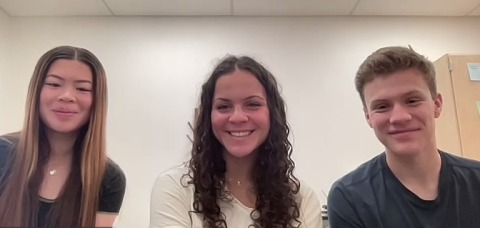As the school year wound down for most students in the Northern Hemisphere in the first couple weeks of June, some students were still actively trying to solve a mystery: why the ABE Foundations of Biotech gel electrophoresis lab was not working the way it should. Now this may not seem like a problem for the students to solve—surely it should be for the teachers or the ABE program staff—but one ABE teacher set forth a challenge for his AP Biology students, giving them this problem to solve among several other options for final semester projects.
Working with ABE Massachusetts staff, Arlington High School teacher David Conneely created a research project in which his students could design experiments to test why the DNA ladder for the ABE lab was not working consistently. “To work with real biotech equipment and ABE to help solve a bigger problem, I thought that it was like an opportunity I could really take advantage of,” says Michelle Chen, a junior in one of Conneely’s classes.
A DNA ladder is a solution that contains a series of well-defined DNA fragments of particular lengths that can be used to identify the approximate number of base pairs in a band of interest. Typically, ABE students learn how to load the DNA ladder over an agarose gel to learn more about DNA.
“The problem with the ladder we and other ABE classrooms are using is that they’re inconsistent,” Conneely explains. “The ladder does not always disperse in a way that makes sense. The bands are closer together than they should be, or they're not fully visible. And that lack of consistency seems to be fairly prevalent throughout the different schools that are using that brand.”

Left to right: Michelle Chen, Ella Connelly, and Rowan Egan, juniors in one of David Conneely’s AP Biology classes at Arlington High School in eastern Massachusetts.
About one quarter of Conneely’s students opted to investigate the ABE gels and ladders for their final projects, and each student or team of students devised different experiments to see what the underlying causes of the inconsistencies might be. Earlier in the year, Conneely had run through the ABE Foundations of Biotech labs, including the gel electrophoresis one, with the students, giving them the foundational skills necessary for these independent research projects.
Juniors Ella Connelly and Rowan Egan tested how different concentrations of the GelGreen used affect two different types of DNA ladders. They made their own gels and hypothesized that the greater the concentration of GelGreen, the clearer the DNA ladder results would be.
They were surprised by what they found: While one type of ladder worked better with a higher concentration of gel, the other worked better at a lower concentration. “I definitely think it was more complicated than we expected,” Connelly says.
Egan added that there were some limitations to their findings. “Because we were only able to run really one gel at each different concentration, one gel could have just run better on a certain day,” he explains. “And so we don't have a very clear understanding of which ladder produces the best kind of DNA ladder at each concentration.”
Chen found similarly complex results from her experiment, which looked at not only different DNA ladder types but also different gel types. She found that time was a major factor, with gels needing to run for longer times than a typical classroom section allows to provide more optimal results. “I expected the ladders to be sort of similar depending on the gel type but it turned out to vary a lot,” she says.
One thing was clear from all three students: They were thinking like true scientists—not only running and executing their own experiments but considering their limitations and future research directions.
That was the entire goal of this inquiry-based project, Conneely says. “What I appreciate about this opportunity to work with ABE on these research projects is that the students are then able to use the skills they developed earlier in the year to become more autonomous in their biotechnology work, both in terms of their thinking, and also in terms of their ability to run the protocols.”
Now in his 15th year of teaching, Conneely strives to bring as much hands-on learning into his science classes as possible. He has a range of teaching and career experiences, from serving in the Peace Corps in Morocco, to teaching biology to immigrants in Brooklyn, to participating in a summer science program at Columbia University, where eventually some of his students interned. Himself inspired to go into biology by his school biology teacher at Arlington High School, Conneely has returned to the same school he attended to inspire the next generation of students there.
Chen, Connelly, and Egan all said how well prepared they felt for their real-world research project with Conneely’s guidance. And all three have plans to continue their exploration of the biosciences and biotechnology. Chen is especially interested in applied biology, maybe biological engineering, and is attending a biotech camp this summer. Connelly wants to add an internship into her schedule for the next year that focuses on biotechnology. And Egan is spending a second summer in a public health internship through Cambridge Health Alliance, working in community-based medicine.
“This research experience made me realize this might be something I am interested in in the future,” Connelly says. Chen adds: “Not many people are privileged to get an opportunity like this—to be able to use real-world technology on real problems; it’s exciting!”
